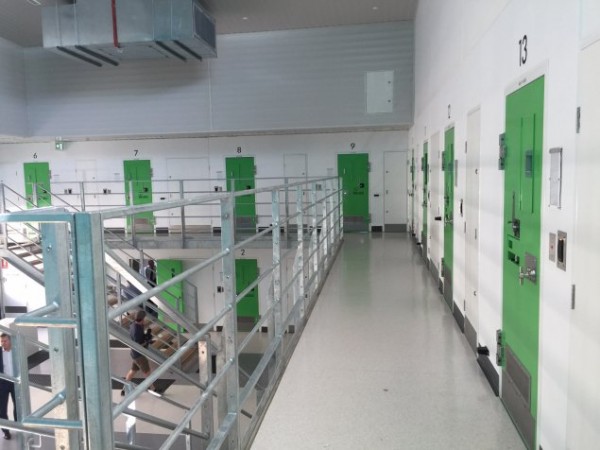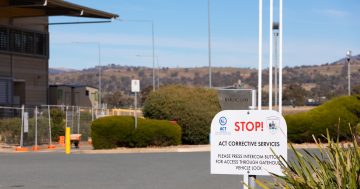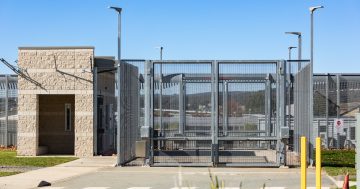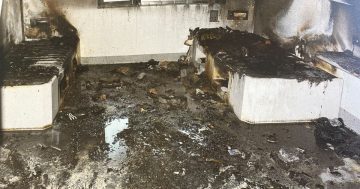
It’s alleged prisoners were drunk when they lit fires in May 2021, causing $3.7 million in damage to Canberra’s jail. Photo: File.
Prisoners with easy access to “homebrew” alcohol and nothing to do were allegedly drunk when they lit fires in May last year, causing more than $3.7 million in damage to the Alexander Maconochie Centre.
An independent review conducted by the Office of the Inspector of Correctional Services (OICS) described the incident as a “damning indictment” of the fact that prisoners at the jail continued to spend much of their time in their unit without any structured activities to occupy themselves with.
“The fact that they had easy access to homebrew is a concern … but of even more concern is that detainees do not have opportunities to fill their days with purposeful activities that will help prepare them for release,” the review found.
The fires took place on 12 May last year in a maximum security double-storey cell block at the jail after prisoners began acting aggressively and verbally abusing staff in the late afternoon, causing them to withdraw from the unit and secure themselves in the Officers Station.
Prison staff believed the detainees were intoxicated on homebrew which they were drinking from a plastic tub.
“The two main instigators made attempts to break into the Officers Station by throwing items from the unit kitchen and detainees’ cells and kicking and punching the panels and windows of the office,” the review found.
A full lock-in was then initiated and 25 officers were called in ahead of a planned operation to enter the unit and control the situation. The review found staff members were concerned for their safety given the detainees were acting aggressively and roaming unsecured.
Detainees then kicked in the side panels and windows of the Officers’ Station and set it on fire around 6 pm. This led to a Code Red being called, before these fires were successfully extinguished.
However, another was then lit in a ground floor cell using clothing and bedding.
Other detainees, who remained locked in their cells until about 6:45 pm when they were evacuated, called the control room to make comments like “open the doors” and “you’re leaving us here to die”.
Outside, some detainees continued to set fire to gym equipment. Negotiations continued late into the night before detainees were eventually assessed by health staff, strip-searched and relocated by midnight.
The damage forced the 46-bed unit to be offline for 11 months and exacerbated the accommodation pressures the AMC is already experiencing.
It was also led to the first use of OC spray (pepper spray) in the history of the AMC. While the review found it was “successfully” used against detainees who had been trying to hinder the corrections’ officers’ progress, it was “concerning that there was no policy or procedure in place at the time to govern its use”.
The review also found that 35 of the 37 unit residents who were inside their unit during the day should not have been there.
“These detainees should have been engaged in activity around the AMC such as gaining skills in industries, participating in education, engaging in programs, recreation, or other activities. Instead, they were sitting around with nothing to do,” it read.
Since 2018, the lack of a “structured day” for detainees has been raised by the Inspector’s office.
A structured day means a timetable of activities such as work, education, programs, and sport and recreational activities that keep detainees occupied, the review said.
It also “may meet other objectives such as rehabilitation and preparation for release”.
But, overall, the OICS review found the emergency was better managed than the riots of November 2020 were.
“Concerningly, however, many of the issues raised by staff after this incident were also raised back [then]. Recommendations made by this office in relation to that incident were accepted by the government, but many remain in progress,” it read.
OICS made four recommendations. It called for the review and update of the prison’s emergency management framework to be completed within six months and for this to include a training scenario that included the evacuation of detainees in case of a disturbance involving fire.
It also recommended the facilities management team be required to submit post-incident reports after being included in any responses. A clear process for documenting detainee property and personal effects that are destroyed or must be destroyed due to fires should also be followed.
The report was released only hours after another scathing review, the blueprint for the prison’s future, which found chronic issues of understaffing and that Corrections Officers felt neither safe nor trusted at work.
This report recommended smoking be banned at the prison and that detainees who had an inflammatory impact on the broader detainee population “and are frequently causing conflict and unrest” should be considered for interstate relocation.





















